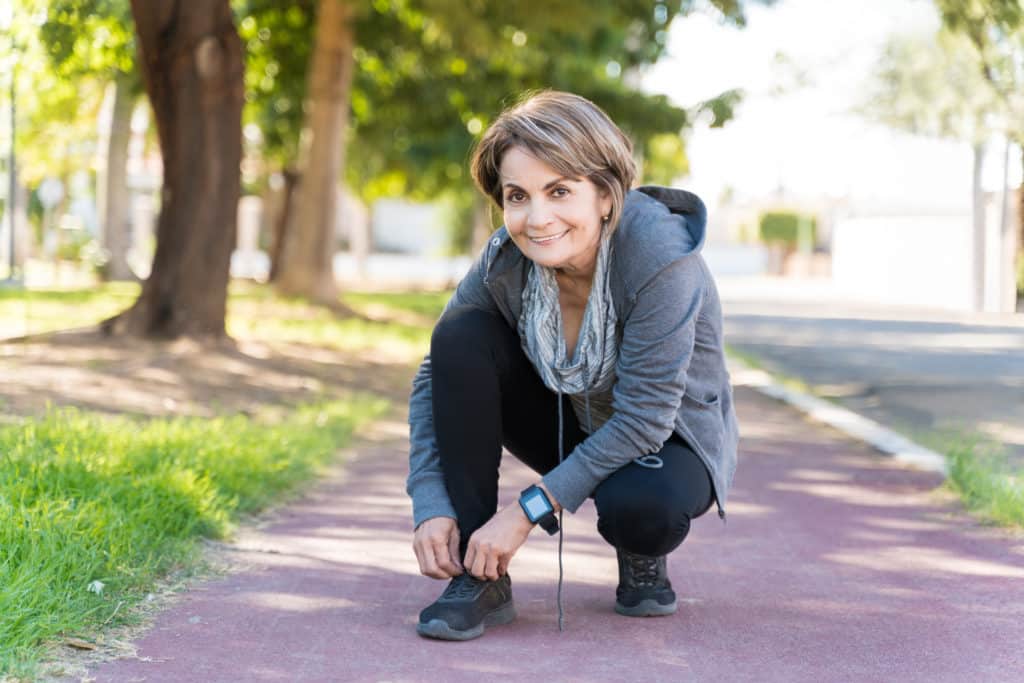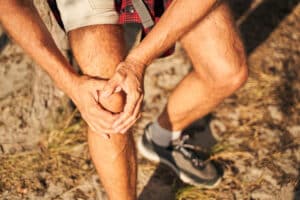Knee osteoarthritis, the most prevalent joint disease globally, impacts over 240 million people. This condition can affect any joint, but it’s most commonly found in the knees, hips, hands, lower back, and neck.
In the case of knee osteoarthritis, the cartilage wears down and becomes rough. As a result, the protective space and tissues within the joint decreases.
These changes can lead to the bones in the knee joint rubbing against each other, forming bone spurs, increasing inflammation and pain, and decreasing joint function.
As a physical therapist, I often see seniors grappling with these challenges. In this article, we’ll delve deeper into the causes, symptoms, and potential treatments for knee osteoarthritis so you can manage pain and stay active.
Recognizing the Symptoms of Knee Osteoarthritis

Knee osteoarthritis presents a variety of symptoms that can vary significantly among individuals. Understanding these symptoms is the first step towards managing the condition effectively.
Here are some of the most common symptoms of arthritis in the knee.
Pain in the Joint
One of the most common symptoms is knee joint pain. This pain can take various forms. It might be a dull ache or a sharp sting, and the severity can range from a slight discomfort to a pain intense enough to hinder your daily activities. The pain can come on suddenly or develop gradually over time.
You might notice that your pain intensifies during strenuous activities like climbing stairs or walking long distances. As the condition progresses, the pain may become more frequent, possibly disturbing your rest or sleep. It’s crucial to listen to your body and seek medical attention when your pain patterns change.
Changes in Range of Motion, Strength & Swelling
Another symptom to be aware of is decreased joint range of motion. You may find it increasingly difficult to move your knee as freely as you once could.
This may also be accompanied by stiffness in the joint, especially in the morning or after sitting for extended periods. However, this stiffness typically lessens within thirty minutes of movement, providing a relatively quick path to relief.
Knee osteoarthritis may also lead to decreased muscle strength. This is often accompanied by a grinding or popping sound in the joint. If you’ve ever heard the term ‘bone-on-bone,’ you’re likely aware that these sounds are caused by the bones rubbing together due to the degeneration of the cushioning cartilage. This is a clear sign of osteoarthritis.
Swelling of the knee joint is another typical symptom. You may also experience a sensation of the knee locking or giving way. These symptoms can make everyday tasks like climbing stairs or walking a challenge.
Other Factors That Might Affect Arthritis
Interestingly, some people with knee osteoarthritis report a correlation between weather changes and increased joint pain. This is thought to be due to changes in atmospheric pressure, which can affect the pressure within the joints.
It’s important to remember that these symptoms can vary significantly among individuals. If you notice any of these signs, it’s advisable to consult a health professional for a thorough assessment. Early detection and intervention can significantly improve the management of knee osteoarthritis, enhancing your quality of life.
I have seen firsthand how understanding these symptoms can empower individuals to seek help and start toward better health. So, stay informed and take action if you notice any of these signs.
Treatment Options for Knee Osteoarthritis
Knee osteoarthritis is a degenerative condition that can gradually affect your daily activities and overall quality of life.
However, it’s important to remember that with proper management and care, you can significantly control your symptoms and enhance the functionality of your joint.
Let’s delve deeper into some common treatment options for knee osteoarthritis that can help you lead an active and fulfilling life.
Exercise

A sedentary lifestyle can fast-track the degeneration of knee cartilage, making it crucial for active older people to engage in light to moderate low-impact physical activity.
Regular exercise helps maintain knee joint function and offers additional health benefits, such as reducing the risk of diabetes, heart disease, and falls. It also helps improve mental health, a crucial aspect of overall well-being.
Developing a fitness plan to support your overall well-being is the best way to ensure you cover all the bases and stay as healthy as possible. Below we’ll cover some of the most important aspects of a well-rounded fitness plan.
If you don’t feel confident creating a fitness plan alone, consult your physical therapist, or look for qualified trainers or health coaches nearby.
Your exercise plan should be customized, considering factors like your osteoarthritis’s severity, as well as your limitations, and personal preferences. This personalized approach boosts your long-term adherence to an exercise plan.
However, avoiding high-impact activities that could further damage the joint is essential. Your plan should include the following cornerstones of movement and exercise.
Cardiovascular Activities
Cardiovascular activities are vital for overall health, and certain varieties are specifically beneficial for managing knee osteoarthritis.
Walking, cycling, and swimming are excellent choices as they are low-impact yet effective in decreasing pain, improving joint function, and enhancing cardiovascular health.
Regular participation in these activities can lead to sustained improvements in knee health and overall well-being.
Strengthening Exercises
Strengthening exercises play a crucial role in managing knee osteoarthritis. Targeting muscles such as the hamstrings, quadriceps, hip abductors, and calves, strength exercises aim to improve muscular strength, provide stability to the joint, and alleviate pain.
Stronger muscles support the knee joint, reduce the load on it, and can significantly improve daily function and reduce pain.
Balance Training
Balance training is especially important for older adults at a higher risk of falls due to knee osteoarthritis.
Activities that enhance balance can help reduce this risk, leading to safer and more confident mobility. Incorporating balance exercises into the daily routine can improve proprioception and stability, making everyday tasks safer and easier.
Stretching Exercises
Flexibility is key in managing knee osteoarthritis. Stretching exercises help improve the joint’s range of motion, contributing to better flexibility and mobility.
Regular stretching can ease joint stiffness, promote better movement, and enhance overall joint health. It’s an essential part of any exercise regimen, especially for individuals looking to maintain or improve their knee function.
Weight Management

Excess weight can significantly increase the risk of developing or worsening knee osteoarthritis due to the additional stress it places on the joints. Maintaining a healthy weight is crucial for reducing knee joint burden and effectively managing osteoarthritis symptoms.
As the knee joint typically supports 3 to 5 times the body weight during walking, even modest reductions in weight can greatly decrease the pressure on the knees, leading to improved joint function and reduced pain levels.
A healthy diet and regular exercise are key strategies in achieving and maintaining an optimal weight, contributing to better management of knee osteoarthritis.
Hot and Cold Therapy
Hot and cold therapy offers an accessible and non-invasive method for managing pain and inflammation associated with knee osteoarthritis.
Cold therapy, or cryotherapy, involves applying a cold pack to the affected knee for 10 to 15 minutes. This can effectively reduce inflammation and numb the area to decrease pain. It’s especially useful after activities that exacerbate joint pain.
Conversely, applying moist heat to the affected knee for 15 to 20 minutes can improve blood circulation, relax muscles, and alleviate joint stiffness. Heat therapy is particularly beneficial before engaging in activities to increase flexibility and reduce discomfort.
Alternating between hot and cold treatments can be a powerful combination for managing knee osteoarthritis symptoms day-to-day.
Medications
Over-the-counter NSAIDs like ibuprofen and naproxen can help relieve inflammation and pain. COX-2 inhibitors, such as celecoxib and meloxicam, may also be recommended due to their fewer gastrointestinal side effects.
However, long-term use of oral NSAIDs should be limited due to potential side effects. Topical NSAIDs applied directly to the skin over the affected area are a safer option and almost as effective as oral NSAIDs.
Duloxetine, an antidepressant approved by the FDA for treating fibromyalgia and diabetic peripheral neuropathy, has also shown promise in controlling pain and improving function in patients with knee osteoarthritis when used for longer than ten weeks.
Joint Injections & Surgical Options
Injecting corticosteroids into the affected joint can decrease inflammation and pain. However, the effects are short-term, and the injections are limited to three or four per year due to potential side effects.
Other injection options include hyaluronic acid, which may reduce inflammation and friction, and platelet-rich plasma (PRP), which uses a concentration of a patient’s blood platelets to promote healing.
In some cases, surgical intervention may be necessary. Cartilage grafting may be used for younger, healthy patients with small areas of cartilage damage.
In patients with early-stage knee osteoarthritis where only one side of the knee joint is damaged, an osteotomy may be used. In advanced cases, partial or total knee replacement may be necessary.
Everyone is unique, and the treatment plan should be tailored to your needs and condition.
Keeping current and understanding the various treatment options for knee osteoarthritis will help you make informed decisions about your health. However, developing a tailored plan with your care team is the most reliable way to minimize pain from knee osteoarthritis. Always consult with a healthcare professional before starting any treatment plan.
Key Takeaways
- Knee osteoarthritis is the most prevalent joint disease globally, causing significant pain and mobility issues.
- Symptoms include varying degrees of joint pain, stiffness, decreased motion, and swelling, profoundly affecting daily life.
- Regular light to moderate exercise is essential for maintaining joint function and overall health.
- Weight management is crucial, as reduced load on joints alleviates pain and improves mobility.
- Hot and cold therapy, medications, and injections offer various options for pain relief and inflammation reduction.
- Surgical interventions are available for advanced cases, providing hope and improved quality of life.
- Every individual’s journey with knee osteoarthritis is unique, necessitating personalized treatment plans.
FAQs
How is knee osteoarthritis diagnosed?
Diagnosis of knee osteoarthritis typically includes a detailed discussion of symptoms and medical history, a physical examination focusing on the knee’s mobility, pain, and structure, and often imaging tests like X-rays or MRI to visualize joint damage and confirm the extent of cartilage wear.
What treatment options are available for knee osteoarthritis?
Treatment options range from lifestyle adjustments like exercise and weight management to medical interventions, including pain relievers, anti-inflammatory medications, physical therapy, and joint injections. In severe cases, surgical options like arthroscopy or joint replacement may be considered.
Are there any lifestyle changes that can improve knee osteoarthritis?
Effective changes include regular low-impact exercise to strengthen muscles and maintain joint flexibility, weight management to reduce knee stress, a balanced diet for overall health, and avoiding activities that overstrain the knee. Hot and cold therapies may also provide symptom relief.
Is knee osteoarthritis curable?
While there is no cure for knee osteoarthritis, a combination of treatments, lifestyle adjustments, and sometimes surgery can significantly manage symptoms and improve joint function, helping maintain an active and comfortable lifestyle.
How does knee osteoarthritis progress over time?
The progression of knee osteoarthritis is generally slow and varies from person to person. Factors like initial severity, weight, and activity levels impact the rate of deterioration. While symptoms like pain and stiffness may gradually increase, with proper management, many can maintain a good quality of life for years. Regular check-ups and adjustments in treatment can help manage the progression.
References
- Mora, J. C., Przkora, R., & Cruz-Almeida, Y. (2018). Knee osteoarthritis: Pathophysiology and current treatment modalities. Journal of Pain Research, 11, 2189-2196. https://doi.org/10.2147/JPR.S154002
- Katz JN, Arant KR, Loeser RF. Diagnosis and Treatment of Hip and Knee Osteoarthritis: A Review. JAMA. 2021;325(6):568–578. doi:10.1001/jama.2020.22171
- Lespasio, M. J., Piuzzi, N. S., Husni, M. E., Muschler, G. F., Guarino, A., & Mont, M. A. (2017). Knee Osteoarthritis: A Primer. The Permanente Journal, 21. https://doi.org/10.7812/TPP/16-183
- American Academy of Orthopaedic Surgeons. (n.d.). Arthritis of the Knee. OrthoInfo. Retrieved from https://orthoinfo.aaos.org/en/diseases–conditions/arthritis-of-the-knee
- Arthritis Foundation. (n.d.). Osteoarthritis. Retrieved from https://www.arthritis.org/diseases/osteoarthritis









